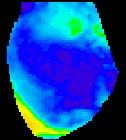|



Solutions for reducing noise from various
sources
Dark Noise (CardioPDA)
The place to begin is to examine the noise
in the dark. This noise should not be larger than a certain size
and should have a flat FFT spectrum. With the CardioPDA system,
measure the dark noise with the following settings:
1. Second stage amplifier low-pass filter: 1 kHz;
2. Second stage amplifier high-pass filter: AC2 on;
3. Use fastest acquisition rate: 1.3 usec;
4. Number of points: 1024;
5. First stage gain: high; and
6. Second stage gain: 50.
Determine the size of the dark-noise by measuring
its RMS value under Output, determine its frequency content by using
the FFT option under Trace. A flat spectrum with an absolute RMS
value of less than 50 is good.
Extraneous Dark Noise (CardioPDA)
There are a number of recognized causes of
a not-flat FFT; all of them can be eliminated. A peak at 60 (50)
Hz (or harmonics) indicates AC noise in the system; 120 or 180 Hz
may come from the room light; peaks around 200 - 300 Hz may come
from acoustic noise (e.g. from the air handling system); a peak
near 1000 Hz may come from oscillation of the amplifier system.
Extraneous Light Noise
After the extraneous dark noise is minimized,
a second class of noise sources, termed extraneous or technical
noise, may be present after illuminating the preparation. Again,
there are a number of recognized causes, all of which can be eliminated.
Fluctuations in the output of the light source:
| |
Tungsten filament lamps.
It is not difficult to provide a power
supply stable enough so that the output of a tungsten filament
bulb fluctuates by less than 1 part in 105. Tungsten filament
sources are almost always used in absorption measurements and
are also preferable in those fluorescence measurements where
relatively large light intensities are obtained (i.e. a photocurrent
> 10-8 amps).
LEDs. Ultra Low Noise LEDs with detached fan from Prizmatix (www.goldstonescientific.com). Low Noise LEDs from Cairn Research (Cairn
Research Ltd).
Laser Diode Illuminator (LDI). Powerful, low noise and narrow bandwidth LDI from 89North and Cairn Research.
You can test for light source noise by looking at the noise with an evenly
illiuminated object with no contrast. If the noise is still present, it is
probably in the light source. |
Vibrational Noise
Another source of extraneous light noise is
vibrations in the light path. This noise tends to be in the frequency
range of 1-50 Hz.
| |
Shutters. The
opening of a shutter attached to the microscope can cause a
very large vibration signal. We found that this noise damps
out over a period of about 1 second. Vibrations from the shutter
can be greatly reduced by mounting the shutter so that it is
not touching the microscope (i.e. on another platform that is
vibrationally isolated from the microscope).
Floor Vibrations.
A number of precautions for reducing the effects of this vibrational
source include eliminating air-water interfaces, eliminating
convection currents in the lamp housing, filtering the saline
to remove particles, and mounting the apparatus on a platform
made from two optical table-tops separated by (and mounted on)
air-filled rubber tubes (obtained from Newport : isolator, air
cushion, #5274). Embedding ganglia in 1-3% agar further reduced
vibrational noise. Minus
K Technology sells Biscuit bench top vibration isolation
tables with very low resonant frequencies. They provide outstanding
vibration isolation. (Choose a model which will support >25
pounds more than the weight of your apparatus because you may
have to add weight to balance the table.) |
Shot Noise
When all of the extraneous noises are reduced enough, the remaining
noise will either be dark noise (very low light intensity) or shot
noise (higher intensity). In the CardioPDA apparatus this crossover
occurs at a resting light photocurrent of about 5 x 10 -10 amps.
In the CardioCCD system the crossover occurs at an intensity about
10 times lower. Shot noise arises from the statistical nature of
photon emission and detection. In a shot-noise limited measurement,
the signal-to-noise ratio is proportional to the square root of
the number of measured photons and the bandwidth of the photodetection
system. In this situation, increasing the signal-to-noise ratio
can only be achieved by 1) increasing the illumination intensity,
2) improving the light-gathering efficiency (e.g. larger numerical
apertures) of the measuring system or 3) reducing the system bandwidth
by lowering the low-pass filter cut-off frequency.
|


